- Read Foreword by Padma Bhushan and
respected Shri Lokesh Chandra. The book subject is well-timed and caught
national attention.
We present information about this fascinating book in two parts. One, is Foreword by the learned and respected Padma Bhushan Shri Lokesh Chandra. Two, are links to author’s words on the book. Also see, links at end of article.
Foreword by Shri Lokesh
Chandra
This ‘pilgrims progress’ of Shri Deepankar reminds me of the words of the great Tang poet Li Shang-yin:
“I who was given in a dream the brush of many colours
Wish to write on petals a message to the clouds of morning.”
A book wrapped in the gold of centuries from a
thousand flowers of the mind. It is a journey of culture on a bullet
train. Shri Deepankarji must have spent six years to pen it and I have read it
through in six hours: it is so fascinating in its flowing diction and minimum
of technical details. It celebrates the last two millennia when Asian nations
made the journey of the mind together. Serene depths of thought, art and piety
confluence in the rapture of roots. The living monasteries in East Asia and the
desolation of the ruins in Central Asia due to theistic violence become the
fascination of eyes in the evocative narrative of Shri Deepankarji.
He opens up the immensity of our lost heritage, like
the grandeur of colossi in the Yün-kang caves which are visible symbols of the
majesty of the Avatamsaka tradition,
reminiscent of the Bamiyan Buddhas. The Sanskrit text of the Gandavyuha-sutra
calls them abhyucca-deva as towering over human life. He writes of the 17m high
Losan in the Longmen caves. Losan is Rocana in Sanskrit. In Japan He is Roshana
Daibutsu at the Todaiji Monastery consecrated on 9 April 752 to give a lasting
embodiment to Japan as a nation. Rocana/ Vairocana means the Buddha of Light
and reminds of the Indian name Roshan Lal.
Read Todaji Monastery – Amalgamation of Indo-Japanese Spirituality
Shri Deepankarji saw gigantic images of the Trinity of Buddhas of the Three Times of past, present and future, in Chinese monasteries. His own name comes from the Buddha of the past: D∂paΔkara. The Buddha of the Present is the historic Shakyamuni and the Buddha of the Future is Maitreya. D∂paΔkara Buddha was a resident of Ramyaka or Ramyavati which has become Lamkan in the modern Dari dialect. It is a valley of lush greenery, a place fit for yogic meditation, where sages have sat in contemplation from the Upanishadic age.
To
see pics of Buddha of the Future at Thiksey Monastery, Ladakh
Shri Deepankarji speaks of holy temples atop mountains
or besides rivers: the first requirement in the yoga-sutras is a beautiful spot
in the captivating surrounds of nature. Why is Shri Deepankarji inspired by the
Buddhist sancta: perhaps the consciousness of his earlier incarnation awakens
him to the plenitude of the subtle and profound, to the deeper ground of
existence, as he is thrilled at every monastery. It is a where without a who.
He speaks of Dizang or Kshitigarbha atop the Jinhua
Mountain in China, which rises 1342 metres above see level. In its heyday
during the Ming and Qing dynasties it had 360 monasteries with 5000 monks and
nuns. It is the most beautiful pilgrimage location in China.
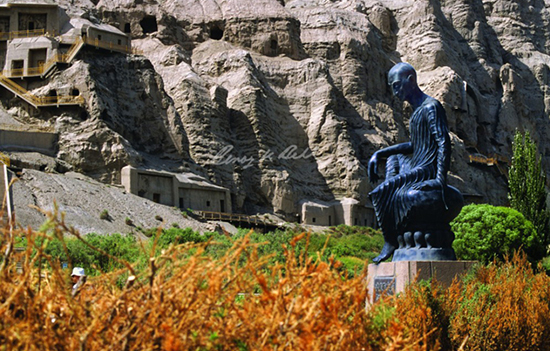 Statue of Kumarajiva, Kizil Caves, Kucha, Xinjiang Uygur Autonomous
Region, China. Pic by Benoy K Behl.
Statue of Kumarajiva, Kizil Caves, Kucha, Xinjiang Uygur Autonomous
Region, China. Pic by Benoy K Behl.
China has four sacred Buddhist mountains: Wutai, Jinhua, Emei and Putuo. They are the counterpart of the Indic concept of
caturdhama in Badrinath, Puri, Dwaraka and Shringeri established by
Shankaracharya. The main deity of Wutaishan is Manjushri, that of Emeishan is
Samantabhadra, and that of Putuo is Avalokiteshvara. Putuo is a transcription
of Potala. The immensity and void of space are the pristine beyond. The four
sacred mountains in China are the ground for the flowering of the heart in a
union of the human and divine.
The three monkeys on the table of Mahatma Gandhi were
given to him by Venerable Fuji Guruji. Gandhiji was curious to know if the
three noble negations not to see evil, not to speak evil, not to hear evil
(mizaru, kikazaru, iwazaru) had any relation to Hanuman. He asked my father
Prof. RaghuVira who told him that in India the animals represent innocence.
They know no guile and have no conditioning. They have an artless purity. A
monkey gave honey to Lord Buddha in the city of Vaishali and was reborn as
Emperor Ashoka. The three monkeys are the honey of the mind. Spiritual values
are integral to life.
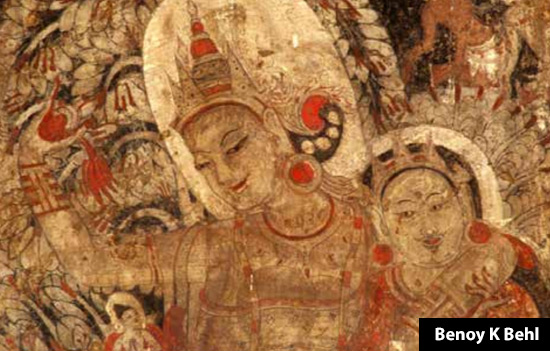 Birth of Buddha, mural, 12th century,
Bagan, Myanmar. Pic by Benoy K Behl.
Birth of Buddha, mural, 12th century,
Bagan, Myanmar. Pic by Benoy K Behl.
Shri Deepankarji speaks of the White House Monastery as the birthplace of Buddhism in China. The Yueh-chih were supplying horses from Kambuja (modern Ferghana) to the Chinese Emperor Shih-huang-ti of the Chin dynasty for the construction of the Great Wall of China. They were Buddhists by faith, Sanskrit was language of their culture, and they gave the name øËŸ or China to the Middle Kingdom by Sanskritising the name of the Chin dynasty (246ñ207 BC). An akåra had to be added to the Chinese word chin for ease of declension in Sanskrit. They had brought Buddhist
scriptures to China in 217 BC but they had to bury them in the ground
due to imperial wrath. Matanga Kasyapa and Dharmaratna came to China from the
Yueh-chih Court at the invitation of the Chinese Emperor.
 Map of route by Hiuen-Tsang as displayed at his memorial at Nalanda, Bihar.
Map of route by Hiuen-Tsang as displayed at his memorial at Nalanda, Bihar.
The high steeds for the Chinese cavalry came from the
lands of the Yueh-chihs to the precincts which were to become the White Horse
Monastery. A graffiti, with the name Hayamvihåra or Horse Monastery, has
been discovered in Uzbekistan. Buddhist monasteries were centres of Dharma
where transnational merchants stayed and made munificent donations. A chain of
monasteries from Ferghana to Chang-an and Loyang linked China to Buddhism.
The Dayunjing is the Mahåmegha-sutra, which was
written in South India, as detailed by Prof. Sylvain Levi. It has an intimate
knowledge of South India and speaks of the glorious reign of a queen on the
Krishna River. Confucianism did not accept an empress and Empress Wu had to
find her legitimation in the Mahamegha-sutra.
Buddhist monks like Itsing, Chintamani from Kashmir
and Bodhiruci the translator of Ratnamegha-sutra lauded her role as Empress.
She rewarded nine monks for their new concept of political power. She supervised
the translation of the Avatamsaka-sutra whose main Buddha is Rocana or Losan in
Chinese. It is understandable that the Losan Buddha has her face (p.31) in the
Longmen Caves.
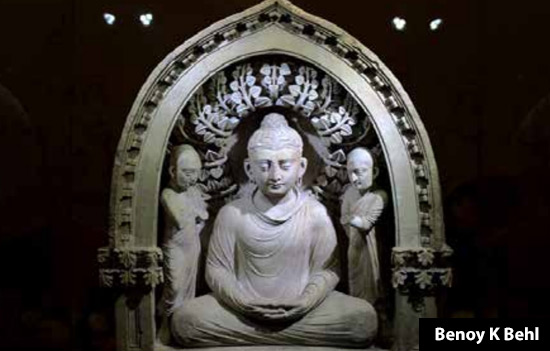 Buddha, 1-2nd century, Tashkant National
Museum, Uzbekistan. Pic by Benoy K Behl.
Buddha, 1-2nd century, Tashkant National
Museum, Uzbekistan. Pic by Benoy K Behl.
The musicians in the frescoes of Dunhuang (p.53) reflect the Sukhavati Pure Land of Amitabha. They represent three stages of nåda-laya. On the first level the musicians play percussion instruments, wind instruments on the second level, and string instruments on the third level. The highest is the anåhata-nåda where the musical instruments are not (an-) played (åhata). They are floating in the sky and are åkå‹h∂ dharana where the mind becomes absorbed in the Supreme (Hatha- yoga-pradipika, stanza 99).
The flying goddesses are
not apsaras or fairies but the four goddesses of worship (puja-devi): offering flowers (goddess Pushpaa), incense (goddess Dhupaa), lamp (goddess D∂paa) and fragrance (goddess Gandhaa).
Puspaa represents samådhi. Dhμupå carries a fuming incense-pot and the burning incense is the
perfection of insight. The fragrance of ethics satisfies all sentient beings. Dipaa symbolizes the light of knowledge,
illuminating the darkness of ignorance. Gandhaa
is the mind of enlightenment. The murals of Dunhuang are related to various
texts and represent philosophical concepts as well as are means to
contemplation. They are the cosmos as a continuous process of unfolding itself.
The immortal winds of the goddesses caress the human mind with the power
dormant in the rhythm of spring. The vibrations of their flight are direction
and directive to enwoven light and love in the hearts of men.
Wutaishan is the Five Peaks Paradise of Manjushri. Wu
means ëfiveí and tai ëpeaksí, named on the anomaly of Chitrakuta of the
Ramayana. Wenshu is Manjushri and not Sarasvati. Manjushri is the
eternally youthful, princely being of wisdom. As the Bodhisattva of
transcendental wisdom he holds the scripture of Prajnaparamita in the left hand
and a sword in the right hand to destroy all that stands against Truth. He has
been the palladium of the state and the family deity of the Manchu emperors who
ruled China from 1644 to 1911 CE. Compare Manchu with manju. Chairman Mao paid
homage at Wutaishan in 1949 before taking oath of office in Beijing. Even
Indian monks came for worship, for instance, Buddhapåli was here in 676 CE. It
has two famous caves: Vajra Cave and Narayana Cave. It is the only holy site
(tirtha) of China mentioned in Sanskrit texts.
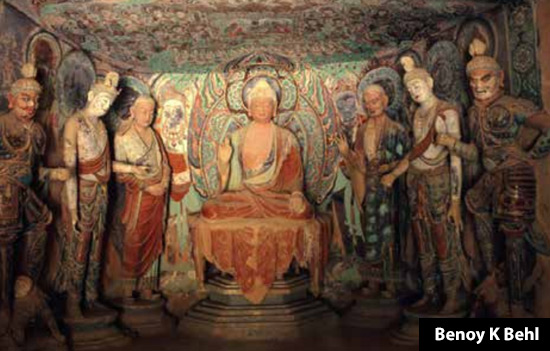 Interior of Mogao Cave no. 45, Dunhuang, China. Pic by Benoy K Behl.
Interior of Mogao Cave no. 45, Dunhuang, China. Pic by Benoy K Behl.
Shri Deepankarji travelled to several cave complexes
in China. In the Indic tradition, caves are syllogisms
of the soul. A cave is a womb for illumination, away from the world to
attain transcendence. As an Upanishad says, the macrocosmic and microcosmic
soul resides in the cave of the heart (anor
aniyan mahato mahiyan atma guhayam). Buddhists were the first to carve out
caves.
The endowment of caves is attested by inscriptions in
the third century BC in Srilanka. The Kizil caves were commenced in the second
century CE. Mogaoku Caves (Dunhuang) means ëCaves of Unequalled Heightí. They
were cathedrals of silence to transcend into the beyond.
Emperor Chinggis Khan united the Mongolian clans and
gave them the generic name Mongol. His imperial
ensign was Five Tridents (Trishul of Lord Shiva), and he had a trident
on top of his helmet. The Mongolian chronicles call him a Chakravarti. His
personal secretaries were bakshi or Buddhist monks from the Uigurs. Bakshi is
the Uigur pronunciation of bhikshu. The bakshis of Chinggis Khan introduced
Buddhism to the Mongols. Dharmasimha (Dharma- Lions) guard the entrance to
Mongolian monasteries. Young poets sing of the lions:
The lion protects our heritage in the moonlight.
Fatherís dreams underfoot,
Motherís fingers on the rosary, Only Buddha in their minds.
Their mantras flying as ornaments of sound.
The character HRIH on the entrance of
Rengejo-in represents Trivikrama Hari or Vishnu. Hari has been syncopated into
the hieronym HRIH.
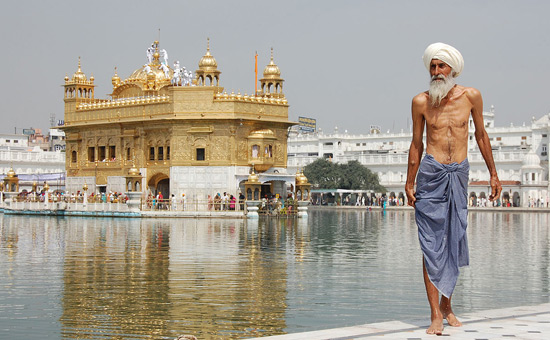 Hari Mandir, Amritsar popularly called Golden Temple.
Hari Mandir, Amritsar popularly called Golden Temple.
Hari has three meanings in Sanskrit: (i) Vishnu the symbol of felicity, (ii) Sun that devotes light and wisdom, and (iii) lion who stands for power. In Buddhism it became the symbol of Amitåbha, the Buddha of Infinite or Transcendent Light. He incarnates in the Japanese Sun Goddess Amaterasu. The imperial family of Japan is descended from Amaterasu: →
Saeda-san explained the symbolism of A. It is called
ajikan and is the absolute of the sound system. It has nothing to do with OM. A
is the divine intensity in the Bhagavad Gita where Lord Krishna says: aksharanam akaro asmi ëof letters I am Aí. In the calligraphy of Kakuban (1095ñ1143 CE) it emerges from a pristinely white eight-petalled lotus: →
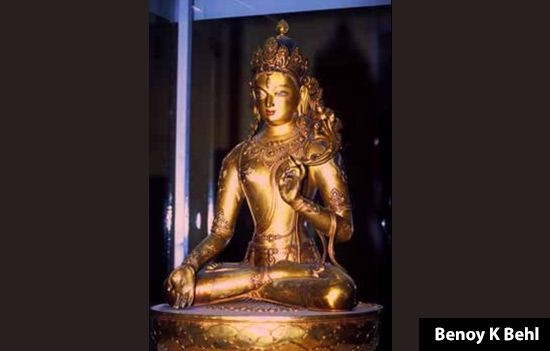 White Tara, 17th century, Zanabazaar
Museum, Ulaanbaatar, Mongolia. Pic by Benoy K Behl.
White Tara, 17th century, Zanabazaar
Museum, Ulaanbaatar, Mongolia. Pic by Benoy K Behl.
Shri Deepankarji has done yoeman service to the Indian
elite in conveying the long trail of Buddhism to Central Asia during the reign
of Ashoka, thence to China along with horses led by monks skilled in Parthian
shots as well as in the sutras, thence to the Land of Morning Calm Korea, and
from there to the Land of the Rising Sun Japan. The name Japan (Nippon in
Japanese) was given by Prince Shotoku in the sixth century from the Sutra of
Golden Light (Suvarna-bhasottama-sutra). The golden light of the Rising Sun is
adored in the gayatri hymn to endow us with the quintessence of the human,
natural and divine.
This flowing and illuminating account of the
pilgrimage of Shri Deepankarji rejuvenates our memories about the tread of
Indian sages and scholars on the pathways of thought which continue to resonate
in the art and architecture, mind and meditation of the East Asian and North
Asian lands.
Shri Deepankarji opens up the deep glow and angelic
wrappings of Lord Shakyamuni and tempts us to be on the way. The horse is
restive, let us be in the saddle.
Read by Author
1. Write-up
in Garwhal Post
2. Introduction
To Buy
book Online
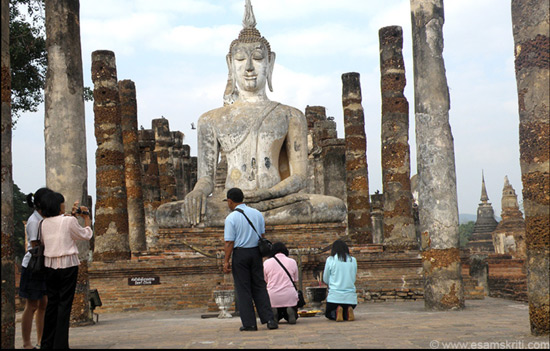 Sukhothai Historical Park, Thailand.
Sukhothai Historical Park, Thailand.
Also read on
same subject
1. Photographic Exhibition of Buddhist Heritage in the world
2. Harmoniou Blend of Hindu, Buddhist and Shinto streams in Japan
3. Names of Buddhist sites in Xinkiang – Sanskrit on the Silk Route
4. The
Bali Temple Run
5. Shared
Heritage of Indian and Mongolia by Prof Lokesh Chandra
6. Pictures
of Northern Frontiers of Buddhism
7. Interplay
of ART between India and Japan
8. About Golden Pagoda – Myanmmar
9. Album – Sukhothai Historical Park, Thailand
10. Album Wats of
Bangkok
11. Album Sleeping
Buddha Ayuthayya
12. Album Wats of
Chiang Mia
13. Album
Emerald Buddha Temple, Bangkok